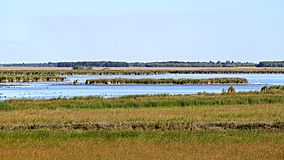Oak Hammock Marsh facts for kids
Quick facts for kids Oak Hammock Marsh |
|
|---|---|
|
IUCN Category IV (Habitat/Species Management Area)
|
|
 |
|
| Location | Rural Municipality of Rockwood / Rural Municipality of St. Andrews |
| Nearest city | Stonewall, Manitoba |
| Area | 20 square kilometres (7.7 sq mi) |
| Designated: | 27 May 1987 |
| Reference #: | 366 |
Oak Hammock Marsh is a special natural area in Manitoba, Canada. It is about 20 km north of Winnipeg, near the town of Stonewall. This important place includes about 20 square kilometers of open marshland. It also has a slightly smaller area of surrounding woods and grasslands. The entire Wildlife Management Area covers 36 square kilometers.
Oak Hammock Marsh is recognized worldwide as a Wetland of International Importance. This means it is protected under the Ramsar Convention. It is also a very important place for birds globally, known as an Important Bird Area. Many different kinds of birds and other wildlife live here.
Contents
History of Oak Hammock Marsh
How the Marsh Was Lost and Restored
Long ago, the area near Lake Winnipeg was a huge marsh, about 470 square kilometers in size. People called it St. Andrews Bog. But starting in 1897, much of this wetland was drained. This was done to create more land for farming. By the early 1960s, almost all of the original marsh was gone. Only about 0.6 square kilometers remained.
Bringing the Wetland Back to Life
Luckily, efforts to bring the marsh back began in 1967. The governments of Manitoba and Canada worked together. They partnered with Ducks Unlimited Canada and other groups. Their goal was to buy back farmland that wasn't great for crops. They wanted to turn it back into a home for wildlife.
By 1974, they had bought 34.5 square kilometers of land. They also built 22 km of special walls called dykes. These dykes help to hold water in three separate marsh sections. They also built 58 islands within these sections. These islands are perfect places for birds to build their nests. In 1984, more work was done. They added more dykes, water controls, and even created a fourth marsh section.
Managing the Marsh for Wildlife
Controlling Water Levels
Oak Hammock Marsh is a wetland that has been rebuilt and is carefully managed. It is designed to be a great place for waterfowl (like ducks and geese) to breed and rest during their migrations. The water levels in the marsh are controlled very carefully.
For example, in wet years, there is a lot of water everywhere. Waterfowl have many other places to nest. So, managers might lower the water level in one or more sections of the marsh. This creates large areas of dried mudflats.
Helping Plants and Birds Grow
This drying and later reflooding helps certain marsh plants grow. These include plants like bulrush and cattail. These plants are important because they provide cover for nesting birds. Without this management, the marsh might just become a shallow lake. It would have a clear shoreline but not much cover for birds.
Some of the land around the marsh is also used to grow cereal grains. This provides extra food for migrating waterfowl in the autumn. It also helps reduce damage to crops on nearby farms.
Hunting Around the Marsh
A Balanced Approach
Some people might think the marsh is only for hunters. They call it a "duck factory." But supporters believe that the money needed to rebuild the marsh would not have been available without the support of hunters. They see the value that wild ducks bring for both recreation and the economy. Oak Hammock Marsh, like other prairie wetlands, supports many types of wildlife, not just game birds.
Where Hunting Happens
Hunting is not allowed inside the marsh itself. It is a safe place for birds. However, game birds like mallards, snow geese, and Canada geese are hunted in the autumn. This happens when they leave the marsh to feed in the surrounding grain fields. There is also a special buffer zone. This zone extends 1 km from the water. Hunting is not allowed in this area either. This helps protect the waterfowl even more.
Ducks Unlimited Canada Office
A Center for Conservation and Learning
The national head office for Ducks Unlimited Canada is located on the western shore of the marsh. This building also serves as a public Interpretive Centre. It is a place where visitors can learn all about the marsh and its wildlife.
Exploring the Marsh
From the Interpretive Centre, you can walk on boardwalks. These paths allow people to explore the marsh and the dykes. When the building was first planned in the 1980s, some people worried. They thought that the visitors and traffic would disturb the wildlife. However, these worries were proven wrong. The wildlife has become used to the building and the people. In fact, the building's roof is now a popular spot for birds to nest!
Images for kids




